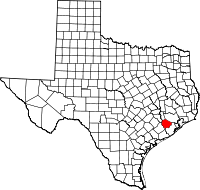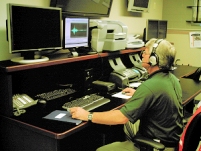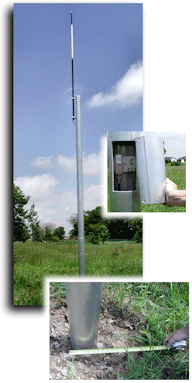
|  Below, Emergency Director Jeff Braun offers perspective on the emergency advisory radio system project, he initiated at Fort Bend County, Texas. Below, Emergency Director Jeff Braun offers perspective on the emergency advisory radio system project, he initiated at Fort Bend County, Texas.The Setting Fort Bend County, located near the Texas Gulf Coast in hurricane country, has a population estimated at 823,779 in the 2020 census. Up 21% since 2015, it's considered one of the fastest growing counties in the United States. US Highways 59 and 90 and State Highways 6 and 36 crisscross the County. At any given time, if you include Gulf Coast area visitors, thousands of motorists could be on more than 2,000 miles of County roads at any given time. The Need In 2005, Emergency Management Coordinator, at the time, Jeff Braun realized his department needed a way to reach these people during hurricane evacuations. He explains it this way: “A confluence of things came together. The US was experiencing more hurricanes. I saw an emergency advisory radio system ad in a professional publication that connected me to Information Station Specialists and theRADIOsource.com. The Texas Department of Transportation uses similar systems, so I was familiar with the concept." The Plan and Preliminary Funding Fort Bend County decided to start small that year with funding they secured from the Department of Homeland Security for enhancing emergency notifications, such as, “significant road closures" or "assisting in emergencies” -- the intent: to build a grow-able system that could be further developed over time, as more funds became available. Jake Haggerty, the Homeland Security Planner for the County’s Office of Emergency Management, coordinated the purchase of two portable emergency advisory radio stations (today called VoiceStars) that could be quickly deployed to trouble spots. Each to be completely wireless with a 10-day operational battery backup, operating primarily on solar power. That is, AC power, which often goes down during emergencies, was not required for the portable stations. Each included immediate automatic NOAA all-hazard notification programming, targeted to the Fort Bend area. And each also broadcasted messages created by Fort Bend County emergency management staff. That same year, 2005, sure enough, the Houston region faced the threat of Hurricane Rita. The portable stations went into action. Fort Bend is immediately north of Brazoria and Galveston Counties, along evacuation routes. Braun relates, “As a result of Hurricane Rita, there was gridlock along the evacuation routes. Vehicles extended from our southern-most to our northern-most borders, caused by backups in the preceding coastal counties, as people tried to leave.” Lessons learned, he says, included: “Just as we already knew, two portable stations were not enough to communicate fully with the citizens and visitors served during hurricane season.” The Solution The Office of Emergency Management called on Information Station Specialists to propose a system that would provide coverage areas at various points across the County, approximately 875 square miles. Information Station Specialists representatives met in Texas with County emergency officials to select installation sites and monitor available frequencies, based on FCC rules and County needs. Information Station Specialists reps are strategically located across the country to assist customers. Their conclusion: add one fixed ALERT AM emergency advisory radio host station with nine satellite stations. The County would continue to deploy trailer-mounted, mobile stations to any special-need trouble spots, such as specific incidents, i.e., river flooding events or hazmat incidents. Additional Funding Emergency Operations in Fort Bend set to work looking at FEMA’s Hazard Mitigation Grant Program (HMGP) funding to pay for the planned expansion of the County’s emergency advisory radio system. The HMGP provided grants to states and local governments to implement long-term hazard mitigation measures after a major disaster declaration. The purpose of the HMGP was to reduce the loss of life and property due to natural disasters and to enable mitigation measures to be implemented during the immediate recovery from a disaster. Braun admits that applying for federal funding is a “competitive endeavor.” Even so, the County garnered 75% of the total expenditure to be paid by FEMA. The County paid the other 25% or about $97,500.  Lessons Learned in Fort Bend Lessons Learned in Fort Bend
In Fort Bend’s case, several jurisdictions within the coverage area needed to cooperate, so stations could be located at municipal fire stations, a state park and even a power plant. “Fort Bend County has a history of working together on emergency-related projects,” says Jeff Braun. “So this wasn’t really an issue; we had formed two regional hazmat response teams, and fifteen of our sixteen jurisdictions were party to the County’s EOC plan. Besides, this wasn’t a real ‘invasive’ project – just a few small antennas with minor electrical costs. The ‘greater good’ was understood by all involved. The state park was excited about the prospect of being able to broadcast info about park closures. The power plant was a long-term entity in our community with the leader of the Local Emergency Planning Committee (LEPC) working there, a relationship we built upon. There was ‘the devil in the details,’ however, such as working out legal agreements, which the County attorney handled on our behalf.” The Future  “Our project is not finished yet,” Braun enjoins. “At this writing in 2007, we are looking at signage options to more fully advertise the stations, so listeners know when and were to tune. We want to use flashing signs along with static signs containing standard text and will use grant money for that as well. Signs will be our primary way of marketing the system, although a few jurisdictions have already began publishing articles about the system. Also, County emergency officials speak about the new emergency advisory radio stations at hurricane workshops they hold for other first responders, such as the Red Cross, hospitals and citizen volunteers. We just went through the Hurricane Dean threat. Most of our messages to date have been NOAA broadcasts and hurricane related preventive messages, created by our staff that we want listeners to be aware of.” “Our project is not finished yet,” Braun enjoins. “At this writing in 2007, we are looking at signage options to more fully advertise the stations, so listeners know when and were to tune. We want to use flashing signs along with static signs containing standard text and will use grant money for that as well. Signs will be our primary way of marketing the system, although a few jurisdictions have already began publishing articles about the system. Also, County emergency officials speak about the new emergency advisory radio stations at hurricane workshops they hold for other first responders, such as the Red Cross, hospitals and citizen volunteers. We just went through the Hurricane Dean threat. Most of our messages to date have been NOAA broadcasts and hurricane related preventive messages, created by our staff that we want listeners to be aware of.” Today, 2023, Jeff serves as executive director of Brazoria County Emergency Services District 3 in Texas. His strategy is to collaborate, communicate and significantly enhance the District's fire suppression and emergency medical response services over the District's 650 square miles. He also consults. Earlier, when working for Fort Bend County, Jeff was named 2006 Emergency Manager of the Year by the Emergency Management Association of Texas (EMAT) for establishing a countywide PIO network, creating a countywide Debris Management Plan, installing an ALERT AM Advisory Radio System, deploying two regional Haz/Mat Response Teams and developing a state-of-the-art EOC. Jeff holds memberships in several professional organizations and was elected to the EMAT Board. He also served on the Houston-Galveston Area Council’s Regional Homeland Security Coordinating Committee, the Regional Collaboration Committee of the Houston Urban Area Security Initiative Working Group and was appointed to the Texas Preparedness Advisory Committee by the State’s Chief of Emergency Management. Braun also serves on the board of directors for the American Association of Information Radio Operators (AAIRO). |
PO Box 51, Zeeland, Michigan, USA, 49464-0051, Phone 616.772.2300, Email
• • •

